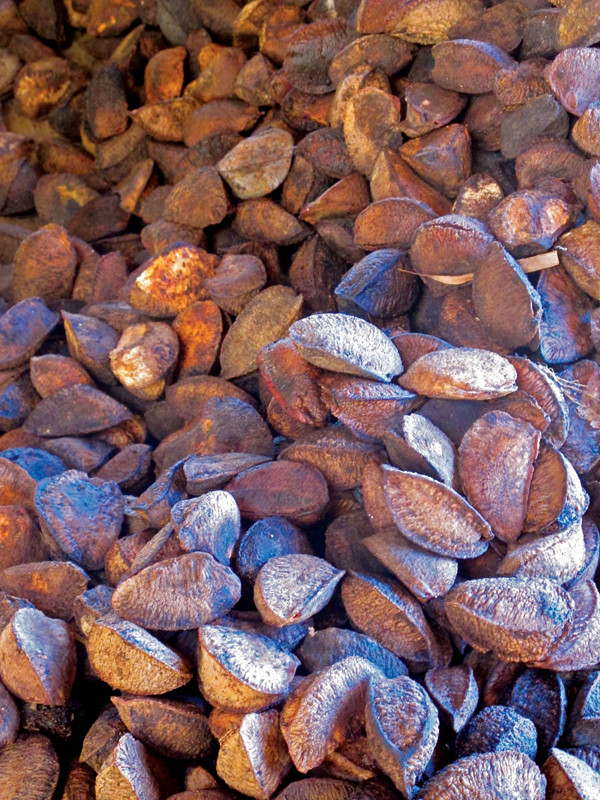
by U.S. Geological Survey Tuesday, January 27, 2015
U.S. Geological Survey selenium commodity specialist Micheal W. George has compiled the following information on selenium, a rare toxic metal.

Brazil nuts contain high levels of selenium. Credit: Gabriela Ramirez Galindo/Center for International Forestry Research.
Selenium, a relatively rare element with diverse uses, is widely distributed within Earth’s crust, but it does not occur in concentrations high enough to justify mining solely for its recovery. Selenium is recovered as a byproduct of nonferrous metal ore processing, principally from the anode slimes associated with electrolytic refining of copper. Slimes from primary copper refining can contain as much as 10 percent selenium, but are generally much lower.
Selenium was discovered in 1817 by Swedish chemists J.J. Berzelius and J.G. Gahn, who initially identified the sample taken from a local mine as tellurium due to its odor when burned. When they discovered there were no tellurium compounds in the mine where the sample originated, they realized they had isolated a new element.
During the 1970s and 1980s, photoreceptors on the drums of plain-paper copiers were the largest single use for selenium. These high-purity selenium compounds have been replaced by organic photoreceptor compounds that do not have the environmental concerns involved with the disposal of selenium compounds. Today, selenium is used in glass and metal production and electronic applications such as solar cells.
Selenium with bismuth is also a substitute in brass plumbing fixtures for lead, which was restricted in any fixtures that provide water for human consumption as part of the Safe Drinking Water Act of 1998. Metallurgical grade selenium is also used as an additive to cast iron, copper, lead and steel alloys.
In small doses, selenium is a micronutrient essential to humans and animals, but in large doses, it can be toxic. In areas with low-selenium-content soils, it is sometimes added to fertilizer to grow animal feed to provide the nutrient to animals and, in turn, the human population — a practice more common outside the United States.
Selenium is used in the production of container glass and other soda-lime silica glass to decolorize the green tint caused by iron impurities. It is also used in art and other glass to produce a ruby red color and in architectural plate glass to reduce solar heat transmission through the glass.
One of selenium’s primary uses is in the production of manganese. China, the leading global consumer of selenium, consumes a large amount of selenium in this way. Owing to large fluctuations in the production of manganese in China and the relatively unchanged global production of selenium, there have been cycles of supply shortfall and surplus in recent years with consequent price fluctuations.
For more information on selenium and other mineral resources, visit http://minerals.usgs.gov/minerals.
In 2013, there was one U.S. producer of refined selenium. Another U.S. copper refinery produced and exported semirefined material containing 90 percent selenium for refining in Asia, and one U.S. refinery generated selenium- and tellurium-containing slimes that were exported for processing.
Average world production in 2013 was estimated to be between 2,700 and 3,000 metric tons.
In 2013, worldwide consumption of selenium by application was metallurgy (40 percent), glass manufacturing (25 percent), agriculture (10 percent), chemicals and pigments (10 percent), electronics (10 percent) and other (5 percent).
Selenium sulfide is used in medicated dandruff shampoos and antifungal soaps.
Cadmium sulfoselenide compounds are used as pigments in ceramics, glazes, paints and plastics to produce a wide range of red, orange and maroon colors.
Selenium was named for the Greek word “selene,” meaning moon, because of its chemical similarity to tellurium, which had been discovered a few years earlier and named for the Latin word “tellus,” meaning Earth.
Alexander Graham Bell used selenium to produce the photophone in 1879, which transmitted speech patterns on a beam of light.
© 2008-2021. All rights reserved. Any copying, redistribution or retransmission of any of the contents of this service without the expressed written permission of the American Geosciences Institute is expressly prohibited. Click here for all copyright requests.